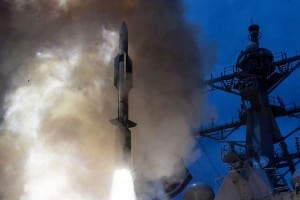Lockheed Martin [LMT] has delivered the first Mid-Range Capability (MRC) prototype battery to the Army, which is the service’s new ground-based weapon designed to fire SM-6 and Tomahawk missiles.
The MRC, also called the Typhon Weapon System, is an Army Rapid Capabilities and Critical Technologies Office (RCCTO) program that will be used to “hit targets in the range between the [future] Precision Strike Missile (PrSM) and the Long Range Hypersonic Weapon.”

“The MRC rapidly progressed from a blank piece of paper in July 2020, to the soldiers’ hands in just over two years. The RCCTO team, as well as our joint service and industry partners, delivered this hardware so Soldiers can begin training as quickly as possible,” Lt. Gen. Robert Rasch, director of the Army RCCTO, said in a statement.
The Army awarded Lockheed Martin a $339.3 million deal in November 2020 to work on the MRC, with plans to begin fielding a prototype for soldier training in the first quarter of fiscal year 2023 and then deliver an operational prototype battery in late FY ‘23 (Defense Daily, Nov. 9).
Lockheed Martin was tasked with integrating the Raytheon Technologies [RTX]-built Navy SM-6 and Tomahawk missiles with a launcher and battery operations centers to form the complete MRC prototype.
“Our collaboration with the U.S. Army enabled us to form a deeper understanding of its most critical mission needs,” Joe DePietro, Lockheed Martin’s vice president and general manager for Naval combat & missile defense systems, said in a statement. “That partnership enabled us to leverage technologies across our ships, launchers and combat systems programs to design, develop, integrate and quickly deliver a solution to meet the Army’s mission requirements. We created new capabilities through integration of existing and evolving technology to ensure our warfighters are ahead of ready.”
The company noted its work to leverage existing missile and launcher systems for the MRC effort “maintains commonality with other critical Army and joint service programs with the Navy, Air Force and Marines and enables the Army to accelerate fielding.”
“Lockheed Martin’s investment in modern engineering processes and digital transformation enabled the company to scale its Aegis Command and Control functions and the Mark 41 Vertical Launching System to quickly meet Army long-range fires needs,” the company wrote in a statement.
Lockheed Martin is also currently building the PrSM missile for the Army, which is the replacement for the legacy ATACMS missile and is set to reach ranges of at least 499 kilometers.